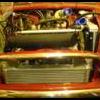Think about what shortening the lugs on the backplate does to the clamping of the plate......
Well that's exactly what I am thinking about. And as I mentioned before, all it does is increase the preload on the spring. If, as is the main point being argued here, the diaphragm spring in a Mini clutch is designed to give zero force at the point where it is flat then preloading it until the spring was flat would actually reduce clamping pressure. But as can be seen from the testing in the linked article, it doesn't give zero force when it is flat and can in fact extend several thou past flat and still return to its original state. The graphs in the article are exactly what I was suggesting were needed. I am very glad to see that someone has actually done research here, and that he stated at the opening that he wanted to know why and wasn't prepared to simply take the word of a book that told him to do it with, no supporting evidence or explanation (much like those of us asking the same thing here, presumably that makes him a chimp too). It also explains exactly why you are feeling less pressure through the pedal without reducing clamping, and it is not because the spring is giving no force at flat. It's because you aren't having to push it inverted. I have also managed to find the info from AP regarding these clutches, and the thing I find odd is that the torque holding figure they publish for the orange clutch is within 1 lbft of what the article suggests is the figure for an incorrectly setup orange clutch. They state 76 lbft and the author found 75 when installed per factory. If anything I would say this validates his figures, but I still cannot fathom why these tolerances were not taken out at the factory and why it never became standard. The only thing I can think is that this setup relies very heavily on the quality control of the clutch spring manufacturer. If the spring is made even slightly wrongly so that it will indeed invert at or just past the flat position, then installing it this way would result in failure. If they allow for the spring to be comfortably on the positive side to begin with, they are safe. But they also give the wear amount as 0.04" which, as shown in the article, is almost all of the available travel. So it shows how important it is to setup the thing near the zero point to begin with and how badly it will be affected by wear. All in all I would say if you are going to fit a green, brown (if you can find either anywhere) or blue spring then it's probably not worth bothering with. If you want an uprated one then it will make it lighter and easier in operation if you do this, which is probably what it said in the books in the first place!
Also, without being argumentative, I still doubt an orange spring can be as light as a Verto. Even setup like this, the Verto design has much more leverage (and will always be less damaging to the thrust bearing due to the fingers Pigeonto, many modern cars have constant contact CRBs and there is nothing wrong with a properly designed bearing running constantly). There is a lot of info about diaphragms with fingers on the manufacturer website that I mentioned previously. Reading that manufacturer's website really shows how the diaphragm design in the pre-Verto must be quite an early one. It's rubbish. The Verto is much more modern in all sorts of details regarding not just how it's made but how it's mounted and everything.
Edited by Dan, 18 August 2013 - 09:15 PM.




 This topic is locked
This topic is locked












